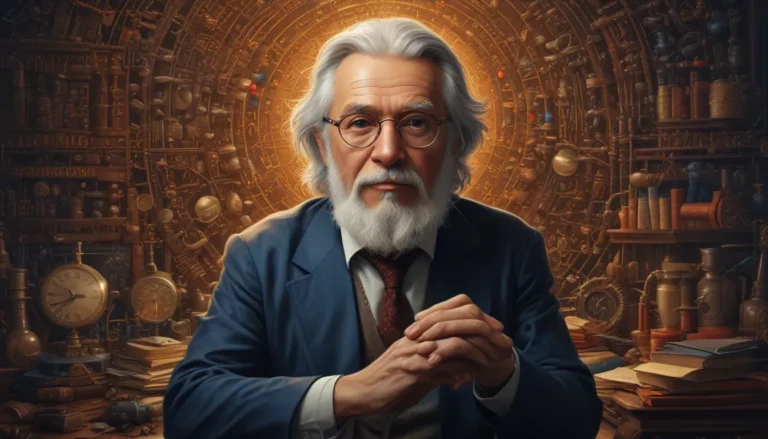The images in our articles may not match the content exactly. They are used to grab your attention, not to show the exact details in the text. The images complement the text but do not replace it.
Subrahmanyan Chandrasekhar, also known as Chandra, was a brilliant astrophysicist whose revolutionary discoveries reshaped our understanding of stars, black holes, and the universe as a whole. Born in British India (now Pakistan) on October 19, 1910, Chandrasekhar’s inquisitive mind and exceptional mathematical abilities set him apart from a young age. His relentless pursuit of unraveling the secrets of the cosmos led to numerous accolades throughout his illustrious career, culminating in the prestigious Nobel Prize in Physics in 1983.
In this article, we dive into 15 captivating facts about Subrahmanyan Chandrasekhar, shedding light on his remarkable achievements, struggles, and unwavering dedication to advancing our knowledge of the universe. From his game-changing work on the Chandrasekhar limit to his influential collaborations with renowned physicists like Albert Einstein, Chandrasekhar’s legacy continues to inspire and shape the future of astrophysics.
Unveiling the Life and Journey of Subrahmanyan Chandrasekhar
Subrahmanyan Chandrasekhar entered the world on October 19, 1910, in Lahore, British India, displaying extraordinary mathematical talent from a tender age. His academic journey led him to Presidency College in Madras, India, where he honed his skills and laid the foundation for his groundbreaking contributions to astrophysics.
Redefining Stellar Evolution Through Chandrasekhar’s Limit
Chandrasekhar’s seminal work on stellar evolution and the structure of white dwarf stars forever changed the landscape of astrophysics. His creation of the Chandrasekhar limit, a crucial threshold determining the maximum mass of a white dwarf before gravitational collapse, remains a cornerstone in our understanding of celestial bodies.
Eponymous Discoveries that Shaped Modern Astrophysics
The name Chandrasekhar is synonymous with a multitude of discoveries and concepts in astrophysics, from the Chandrasekhar mass to the Chandrasekhar number, each playing a pivotal role in expanding our knowledge of the cosmos.
Lessons in Academic Excellence and Mentorship
Throughout his academic career, Chandrasekhar held esteemed positions, including serving as the Morton D. Hull Distinguished Service Professor of Theoretical Astrophysics at the University of Chicago. His mentorship of aspiring scientists paved the way for future groundbreaking discoveries in the field.
Pioneering Contributions to General Relativity and Black Holes
Chandrasekhar’s significant contributions to general relativity, particularly in relation to black holes, shaped our understanding of these enigmatic cosmic entities. His research on the collapse of massive stars and his prediction of black holes’ existence laid the groundwork for subsequent scientific advancements.
The Mathematical Brilliance of Subrahmanyan Chandrasekhar
At the core of Chandrasekhar’s achievements lay his exceptional mathematical intellect. His ability to seamlessly apply complex mathematical concepts to astrophysical phenomena propelled his groundbreaking discoveries and expanded our comprehension of the universe.
Commemorating a Legacy: The Chandra X-ray Observatory
In recognition of Chandrasekhar’s indelible contributions to astrophysics, NASA christened its flagship X-ray telescope the “Chandra X-ray Observatory.” This cutting-edge space telescope continues to unveil invaluable insights into the X-ray universe, carrying forth Chandrasekhar’s legacy.
Embracing International Collaboration and Scientific Exchange
Chandrasekhar’s collaborations with scientists worldwide exemplified his commitment to fostering scientific cooperation and the exchange of ideas. His work transcended geographical boundaries, leaving a lasting impact on the global scientific community.
A Humble Giant: Chandrasekhar’s Enduring Legacy
Despite his numerous accolades and recognitions, Chandrasekhar remained humble and modest throughout his life. His kindness, generosity, and willingness to mentor aspiring scientists underscored his profound impact on astrophysics and the scientific community at large.
A Trailblazer in Theoretical Astrophysics
Chandrasekhar’s research spanned a diverse array of topics within theoretical astrophysics, from stellar structure to radiative transfer and celestial dynamics. His multidisciplinary approach bridged the gap between theory and observation, laying the groundwork for future astronomical advancements.
Celebrating Chandrasekhar’s Impact on Hydrodynamic and Hydromagnetic Stability
Chandrasekhar’s groundbreaking work in the fields of hydrodynamic and hydromagnetic stability expanded our understanding of fluid flow stability in the presence of magnetic fields, paving the way for groundbreaking developments in astrophysical research.
Forever Immortalized: Chandrasekhar’s Influence on Astrophysics
Subrahmanyan Chandrasekhar’s profound impact on astrophysics continues to resonate, with his legacy enduring through numerous accolades and honors, including the National Medal of Science in the United States and honorary fellowship in the Royal Society of London.
Inspiring the Scientists of Tomorrow
Chandrasekhar’s unwavering commitment to advancing our understanding of the universe serves as an inspiration to budding scientists and researchers, exemplifying the transformative power of intellectual curiosity and passion for knowledge in shaping the future of astrophysics.
Charting Chandrasekhar’s Impact: A Conclusion
In conclusion, Subrahmanyan Chandrasekhar’s remarkable contributions to astrophysics have left an indelible mark on the scientific community, reshaping our understanding of stellar evolution, black holes, and the intricate fabric of the cosmos. His extraordinary intellect, humility, and dedication to unraveling the mysteries of the universe cement his position as a pivotal figure in scientific history.
FAQs: Unveiling Chandrasekhar’s Legacy
- Who was Subrahmanyan Chandrasekhar?
Subrahmanyan Chandrasekhar was a prominent Indian-American astrophysicist whose groundbreaking work revolutionized our understanding of stellar evolution and black holes.
- What were Chandrasekhar’s major achievements?
Chandrasekhar’s major achievements include his pioneering work on white dwarf stars, formulation of the Chandrasekhar limit, and significant contributions to the physics of black holes.
- What is the significance of the Chandrasekhar limit?
The Chandrasekhar limit defines the maximum mass a white dwarf star can attain before succumbing to gravitational collapse and exploding as a supernova.
- How did Chandrasekhar’s research impact our understanding of black holes?
Chandrasekhar’s research laid the groundwork for our comprehension of black holes, demonstrating that stars collapsing beyond the Chandrasekhar limit transform into black holes, where gravitational forces are so intense that even light cannot escape.
- What awards did Chandrasekhar receive for his contributions to astrophysics?
Chandrasekhar was honored with the Nobel Prize in Physics in 1983 for his groundbreaking theoretical studies on the physical processes shaping the structure and evolution of stars.
Subrahmanyan Chandrasekhar’s legacy as a trailblazing astrophysicist continues to inspire and shape the future of scientific exploration. His pioneering research, humble demeanor, and relentless pursuit of knowledge serve as a beacon for aspiring scientists worldwide, underscoring the transformative impact of curiosity and dedication on our collective understanding of the universe.






